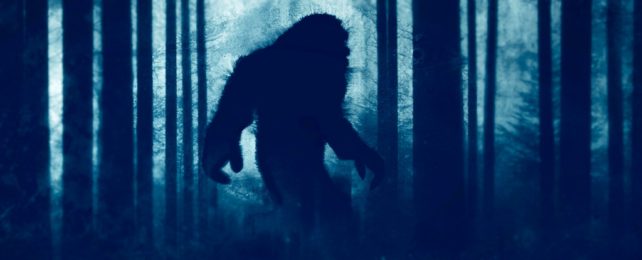A burly figure emerges from the shadows of a forest, only to lumber off into the cover of trees once again.
It's a scene that's been caught from the corner of a thousand human eyes, yet no one is any closer to looking a Bigfoot or a Sasquatch square in the face. If someone were to meet the mythical creature's gaze, they might be surprised by what they find looking back at them.
A data scientist by the name of Floe Foxon has shown that most Bigfoot sightings in the United States and Canada were probably black bears, plodding about on their hind legs.
American black bears (Ursus americanus) usually walk on all fours, but will stand on their hind legs if it means they get a clearer view or a stronger whiff of something interesting. And from this position, they can appear uncannily human-like – albeit rather hairy.

This isn't the first time that scientists have suggested black bears as the explanation for the Bigfoot phenomenon.
In 2005, one scientist compared projected black bear populations with reported sasquatch sightings in the northwest corner of the US. However, he concluded that a species of animal other than the American black bear is responsible for sightings of this mythical creature.
But in 2009, another paper based in the same region showed a high degree of overlap between black bear populations and sasquatch spottings.
Foxon has now expanded on prior results by extending the analysis to all places in the US and Canada where black bears and humans live near one another.
The data he used for Bigfoot sightings came from the Bigfoot Field Researchers Organization, which keeps a geographic database of eyewitness reports mostly from the twentieth century onwards.
Foxon then compared this information to local data on black bear density and spread as well as human population densities. He says this an improvement on the simplified projections used in previous papers.
According to Foxon's rigorous regression model – which shows if changes seen in one variable are associated with changes in another – Bigfoot sightings are largely explained by misidentified black bears.
In areas with high numbers of black bears and humans, more people see Bigfoot, and this is especially true in the Pacific Northwest.
In Texas and Florida, on the other hand, black bears are not nearly as common, despite the fact that sasquatch sightings in these two states are common.
"Notably, sasquatch sightings have been reported in states with no known breeding black bear populations," Foxon admits.
"Although this may be interpreted as evidence for the existence of an unknown hominid in North America, it is also explained by misidentification of other animals (including humans), among other possibilities."
Bigfoot? This footage was captured 10/24/13 by Josh Highcliff.
— The Insomnia Society (@insomsociety) January 10, 2023
9 miles west of Tunica, Mississippi while hunting on his property.
When it stood up he fled out of fear. It has been hailed as one of the best Sasquatch videos ever taken. What do you think? #paranormal #creepy pic.twitter.com/ifv4e9dhlL
In general, however, states like Texas and Florida are exceptions to the rule. On average, Foxon has found one sasquatch sighting is expected for every 900 black bears in a given US state or Canadian province.
Elsewhere in the world, bears might also be fooling people into seeing mythical hominids.
In the mountains of Asia, for instance, it's likely that the Yeti is actually just an Asian black bear, Himalayan brown bear, or Tibetan brown bear covered in snow.
Physical evidence that has been gathered of the Yeti in the past, like teeth and hair, has always turned out to belong to another known animal, and it's usually a bear.
"In conclusion," Foxon writes, "if bigfoot is there, it may be many bears."
The study was published in bioRxiv.
